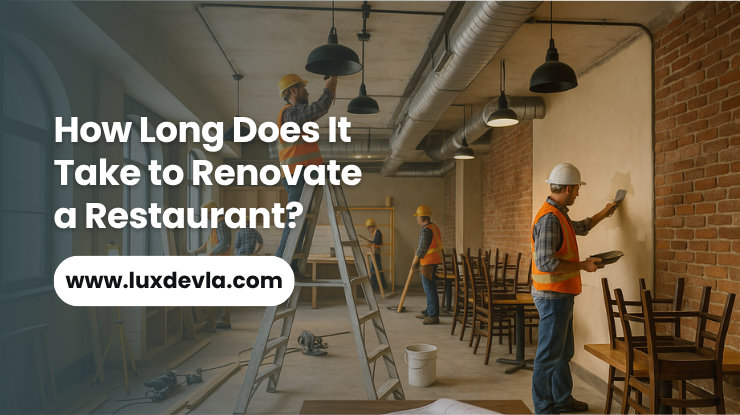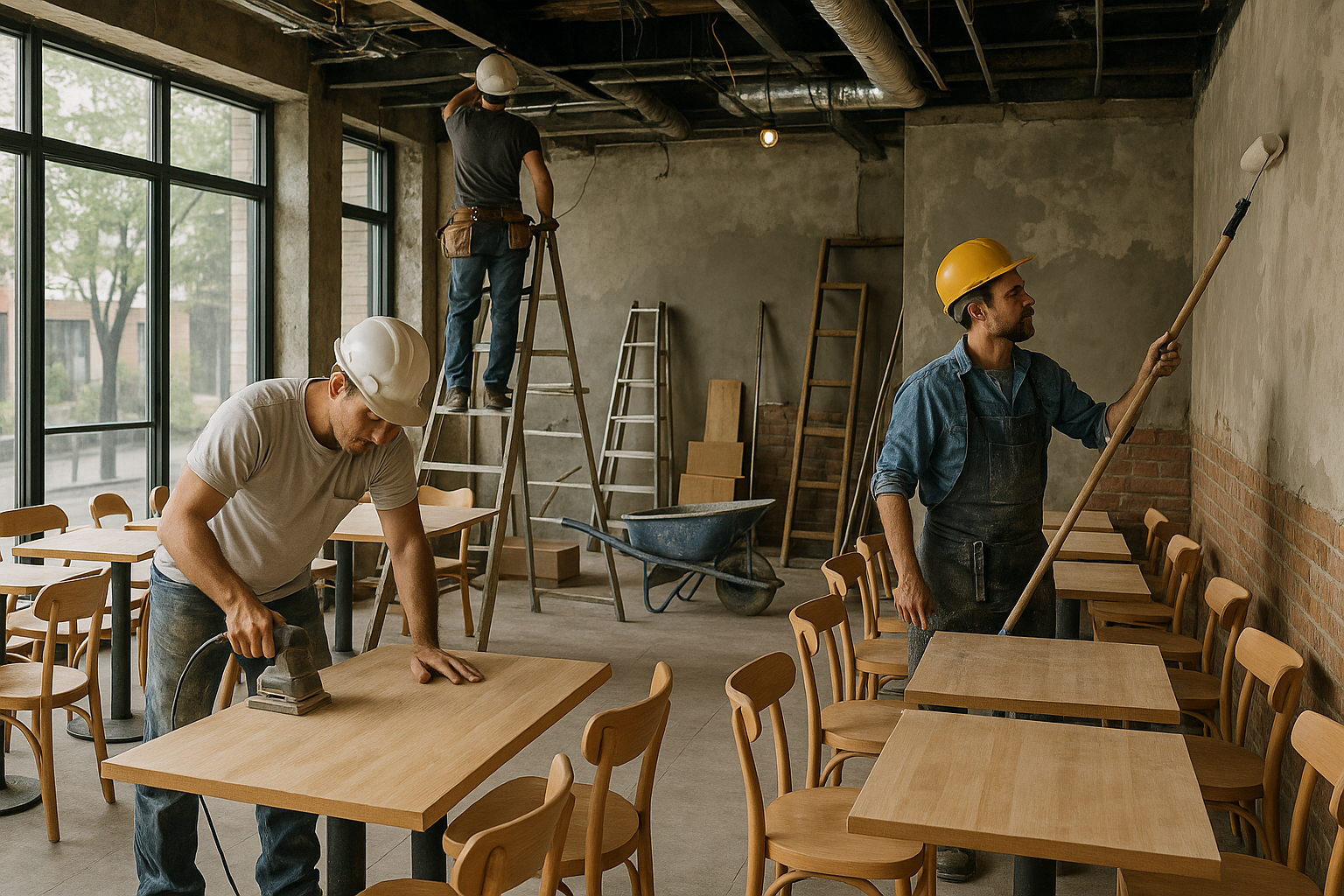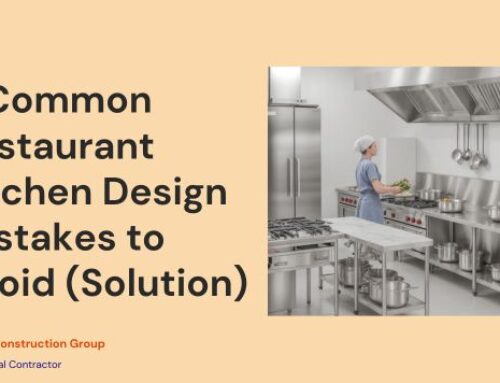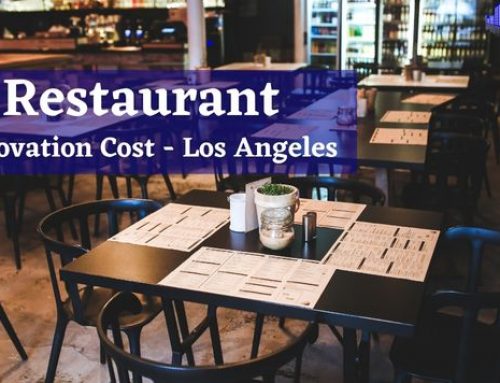Whether you’re planning to refresh a cozy bistro, retrofit a commercial kitchen, or build out a new fine dining concept from a raw shell, understanding your renovation timeline is critical.
For most restaurant owners, especially in high-regulation zones like Los Angeles, the duration isn’t just about construction.
It’s a multi-phase journey involving:
- Health department permits,
- Architectural planning,
- General contractor coordination,
- Inspections, and
- Logistical hurdles like custom equipment lead times or structural retrofitting.
While the average restaurant renovation in the USA can span anywhere from 3 to 12 months, timelines may vary widely based on project complexity, existing conditions, and city-specific regulations.
The U.S. restaurant construction industry reached a robust $9.3 billion in 2024 and is estimated to reach $9.6 billion in 2025, underscoring how strategic renovations remain a key investment for restaurant owners .
A small cosmetic refresh may wrap in under 6 weeks, but a full-scale remodel or new build-out—especially in older buildings—can extend beyond a year.
At LuxDevLA, we specialize in delivering hospitality-grade renovations that balance creative vision with commercial performance. Whether you’re revamping your current space or starting from scratch, our team ensures your restaurant renovation timeline aligns with both your operational goals and regulatory realities.
We integrate advanced project management, permit expertise, and tailored interior solutions to get you open faster and smarter.
Contents
- Average Restaurant Renovation Timelines by Project Scope
- The Restaurant Construction Timeline: From Vision to Grand Opening
- Phase 1: Planning & Design Process (Estimated: 4–8 weeks)
- Phase 2: Permitting and Regulatory Approvals (Estimated: 6–16+ weeks)
- Phase 3: Contractor Bidding and Pre-Construction Logistics (Estimated: 3–5 weeks)
- Phase 4: Construction and Build-Out (Estimated: 8–20+ weeks)
- Phase 5: Final Prep, Inspections, and Grand Opening (Estimated: 2–4 weeks)
- Restaurant Renovation Timeline: Phase Summary Table
- What Slows Down a Restaurant Renovation & How to Prevent It?
- Common Delays and How to Avoid Them:
- Final Words
- FAQs About Restaurant Renovation
- What permits do I need to renovate a restaurant in Los Angeles?
- Can I renovate my restaurant without closing it?
- How often should a restaurant be renovated?
- Do I need an architect for a restaurant remodel?
- What is the cost per square foot for restaurant renovation in the USA?
- How do health department inspections affect renovation timelines?
- Can I get financing for a restaurant renovation?
- What’s the difference between commercial kitchen upgrades and full renovation?
- How far in advance should I plan a restaurant remodel?
- What mistakes should I avoid in a restaurant renovation project?
Average Restaurant Renovation Timelines by Project Scope
How long your restaurant renovation takes depends heavily on the scope of work involved. A cosmetic refresh requires a far shorter timeline than a full-scale gut renovation or a new commercial kitchen build-out.
To help you set realistic expectations, here’s a breakdown of average timelines for different types of restaurant renovation projects in the USA:
| Renovation Type | Typical Duration |
|---|---|
| Cosmetic Refresh | 3–6 weeks |
| Minor Remodel (no layout changes) | 2–4 months |
| Major Renovation (structural, kitchen, systems) | 5–9 months |
| Full Build-Out (shell to finish) | 8–12+ months |
Each project type involves its own unique set of steps, inspections, and stakeholder coordination from minor interior upgrades to extensive MEP (mechanical, electrical, plumbing) installations.
When estimating your restaurant construction timeline, consider both the visible work and the behind-the-scenes requirements, such as permit lead times, design revisions, and health department approvals.
Well, understanding your project’s category is just the first step. Let’s now walk through what each phase of a typical restaurant renovation includes, so you can anticipate every milestone from blueprint to grand opening.
With U.S. consumer spending on dining expected to climb from $895.1 billion in 2024 to $921.7 billion in 2025, now is a compelling time to modernize your restaurant space and capture growing market share.
The Restaurant Construction Timeline: From Vision to Grand Opening
Renovating a restaurant isn’t just about tearing down walls and installing new fixtures – it’s a structured, multi-phase process that involves planning, permitting, construction, inspections, and final preparations.
Each phase is important in determining how long it will take to renovate a restaurant, especially when operating under city-specific building codes and health regulations.
Phase 1: Planning & Design Process (Estimated: 4–8 weeks)
This initial stage lays the foundation for the entire project. It includes:
- Finalizing the menu and concept (which influences layout and kitchen flow)
- Hiring your architect, interior designer, and general contractor
- Creating schematic designs for the front-of-house and back-of-house
- Developing full construction documents for plumbing, HVAC, electrical, and structural needs
This is also when zoning checks and code reviews begin. In cities like Los Angeles, working with professionals who specialize in hospitality spaces can cut weeks off this phase.
Once your plans are finalized and construction documents are approved, it’s time to face what many owners consider the most unpredictable step: securing permits and approvals.
Let’s break down how long that can take—and why it often becomes a bottleneck.
Phase 2: Permitting and Regulatory Approvals (Estimated: 6–16+ weeks)
For many restaurant renovations, this is the longest and most unpredictable phase. Permitting involves navigating a complex network of local, state, and federal regulations, and in high-density cities like Los Angeles, it’s not uncommon for this step to extend your restaurant renovation timeline by several months.
Here are the typical approvals required:
- Building Permits (structure, occupancy, zoning compliance)
- Health Department Permits (commercial kitchen layout, sanitation zones)
- Plumbing, Electrical, and Mechanical Permits (MEP)
- Fire Department / Fire Marshal Approval
- Liquor License (can take 4–6 months separately if needed)
Pro Tip: Hiring a local general contractor or architect experienced with restaurant permits can dramatically reduce delays. At LuxDevLA, our team manages the entire permitting workflow, coordinating directly with building inspectors and health officials to minimize surprises.
Phase 3: Contractor Bidding and Pre-Construction Logistics (Estimated: 3–5 weeks)
After your design documents are finalized and permits are in motion, the next step is to hire the right team to execute the build. This phase isn’t just about comparing quotes—it’s about finding experienced professionals who understand hospitality spaces, local regulations, and how to stay on schedule.
Here’s what this phase includes:
- Sending Out Bid Packages: General contractors review your architectural plans and submit detailed cost and schedule proposals.
- Vetting and Interviews: You’ll evaluate contractor experience, insurance, references, and past restaurant projects.
- Negotiations & Finalization: Contracts are signed, project scopes are defined, and build schedules are confirmed.
With your contractor selected and timelines confirmed, it’s time to bring the renovation to life.
Phase 4: Construction and Build-Out (Estimated: 8–20+ weeks)
This is the heart of your restaurant renovation—the moment when blueprints transform into physical reality. Timelines vary depending on the renovation type, but construction typically follows a logical sequence that allows inspectors and trades to move efficiently through the space.
Construction Milestones & Timeframes:
- Demolition(1–2 weeks): Removal of walls, flooring, and existing fixtures.
- Framing & Structural Work(2–4 weeks): Rebuilding interior layout, kitchen walls, and structural modifications.
- Rough-Ins (MEP Systems)(3–5 weeks): Installation of plumbing lines, electrical wiring, gas connections, and HVAC infrastructure.
- Drywall & Finishes(2–4 weeks): Walling, flooring, tile, painting, and lighting installation.
- Kitchen Equipment & Bar Systems(1–2 weeks): Setting in place hoods, ovens, refrigeration, sinks, walk-ins, and bar fixtures.
- Final Fixtures & Furnishing(1–2 weeks): Tables, seating, shelving, POS terminals, and design elements.
Pro Insight: Timelines can shift based on permit inspection scheduling, subcontractor availability, or supply chain slowdowns, especially for imported or custom kitchen components.
Working with a hospitality-focused builder like LuxDevLA helps ensure proper sequencing, faster inspections, and minimal rework, all of which keep your restaurant construction timeline on track.
Phase 5: Final Prep, Inspections, and Grand Opening (Estimated: 2–4 weeks)
“What happens before a restaurant opens after renovation?” This phase directly aligns with user searches asking what’s needed to open legally and successfully.
Final Steps Before Opening:
- Final Inspections: City inspectors, the fire marshal, and the health department will each perform final walkthroughs to verify code compliance, sanitation standards, and safety measures.
- Punch List Completion: Your contractor addresses remaining to-dos—like adjusting lighting, fixing minor flaws, or finishing trim work.
- Staff Hiring & Training: Your team gets oriented with the restaurant kitchen layout, equipment, POS systems, and service flow.
- Stocking & Test Runs: From liquor inventory to kitchen supplies, everything is brought in and tested during a soft opening.
At LuxDevLA, we not only build your space—we walk with you through the final details, ensuring your restaurant renovation finishes strong and opens with confidence.
Restaurant Renovation Timeline: Phase Summary Table
| Phase | Estimated Duration | Key Activities | Primary Stakeholders |
|---|---|---|---|
| Planning & Design | 4–8 weeks | Concept development, hiring an architect & contractor, floor plans, construction docs | Owner, Architect, Designer |
| Permitting & Approvals | 6–16+ weeks | Submitting for building, health, fire permits, zoning, and MEP reviews | Architect, Contractor, City Agencies |
| Contractor Bidding | 3–5 weeks | Bid collection, contractor interviews, and contract finalization | Owner, Contractor, Legal |
| Construction & Build-Out | 8–20+ weeks | Demolition, framing, MEP installs, finishes, kitchen/bar install | Contractor, Subcontractors |
| Final Prep & Opening | 2–4 weeks | Final inspections, punch list, staff training, soft launch | Owner, Staff, Inspectors |
Now that you’ve seen the full renovation timeline laid out phase by phase, it’s important to recognize that not everything always goes according to plan. From permit delays to material shortages, even well-prepared projects can hit unexpected roadblocks. But with the right strategies, many of these disruptions can be anticipated—or even avoided altogether.
Let’s explore the most common reasons why restaurant renovations fall behind schedule, and what you can do to keep your project moving forward.
What Slows Down a Restaurant Renovation & How to Prevent It?
Renovating a restaurant is a complex operation with many moving parts. While some delays are outside of your control, many are predictable and preventable. Identifying these pitfalls early can save you weeks, if not months, on your restaurant renovation timeline.
Common Delays and How to Avoid Them:
| Delay Factor | Why It Happens | Prevention Strategy |
|---|---|---|
| Permit Bottlenecks | Backlogs in city departments or missing documentation | Start permitting as early as Phase 1; hire local experts who know city workflows |
| Scope Creep | Adding features mid-project causes rework and schedule resets | Finalize design and equipment list before demo; avoid late-stage changes |
| Building Surprises | Older buildings may reveal mold, asbestos, and plumbing issues | Budget for contingency (10–15%); conduct a full site inspection up front |
| Custom Equipment Lead Times | Specialized items like hoods, tile, or millwork can take months | Order long-lead items immediately after contract signing |
| Contractor Inexperience | Poor sequencing permits missteps or poor quality control | Work with vetted teams that specialize in restaurant builds |
| Cash Flow Interruptions | Unexpected expenses halt progress | Have a liquidity buffer and financing plan in place before construction begins |
At LuxDevLA, our team anticipates these issues with predictive scheduling, phased permitting, and keeping your project efficient and timeline-driven from start to finish.
Final Words
Your restaurant’s renovation timeline isn’t just a matter of weeks or months – it’s a strategic investment in your brand’s future. With the right planning, partners, and execution strategy, you can open faster, avoid costly delays, and create a space that performs as beautifully as it looks.
Contact us for Restaurant Remodeling & Renovation
FAQs About Restaurant Renovation
What permits do I need to renovate a restaurant in Los Angeles?
To renovate a restaurant in LA, you need building, health, fire safety, and MEP permits; liquor licenses are handled separately and take longer to process.
Can I renovate my restaurant without closing it?
Yes, phased renovations allow partial operations, but health code and safety compliance must be maintained throughout construction.
How often should a restaurant be renovated?
Experts recommend renovating every 5–7 years to maintain brand appeal, meet code updates, and refresh customer experience.
Do I need an architect for a restaurant remodel?
Yes, most cities require a licensed architect to draft structural, kitchen, and code-compliant drawings before permit approval.
What is the cost per square foot for restaurant renovation in the USA?
Costs typically range from $150–$500/sqft depending on location, scope, materials, and labor market conditions.
How do health department inspections affect renovation timelines?
Health inspections are required before opening and may delay timelines if equipment placement, ventilation, or sanitation zones are non-compliant.
Can I get financing for a restaurant renovation?
Yes, restaurant renovations can be financed through SBA loans, equipment financing, or private commercial lenders.
What’s the difference between commercial kitchen upgrades and full renovation?
Kitchen upgrades target specific systems or compliance, while full renovations involve layout, dining areas, structure, and finishes.
How far in advance should I plan a restaurant remodel?
Plan at least 6–9 months ahead to accommodate design, permits, contractor bidding, and material lead times.
What mistakes should I avoid in a restaurant renovation project?
Avoid scope creep, vague contracts, ignoring city code, and underbudgeting; clear timelines and expert partners reduce risk.




